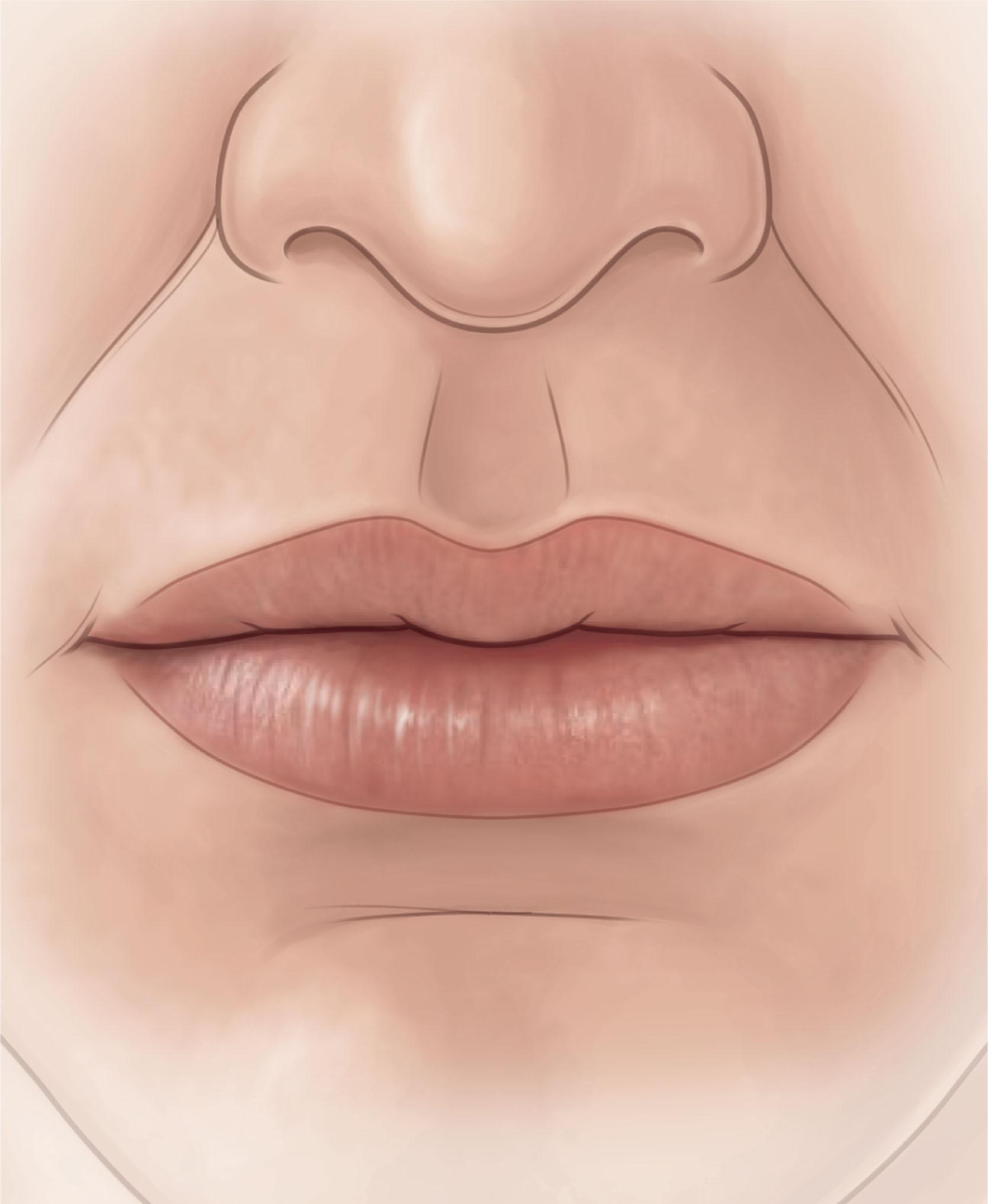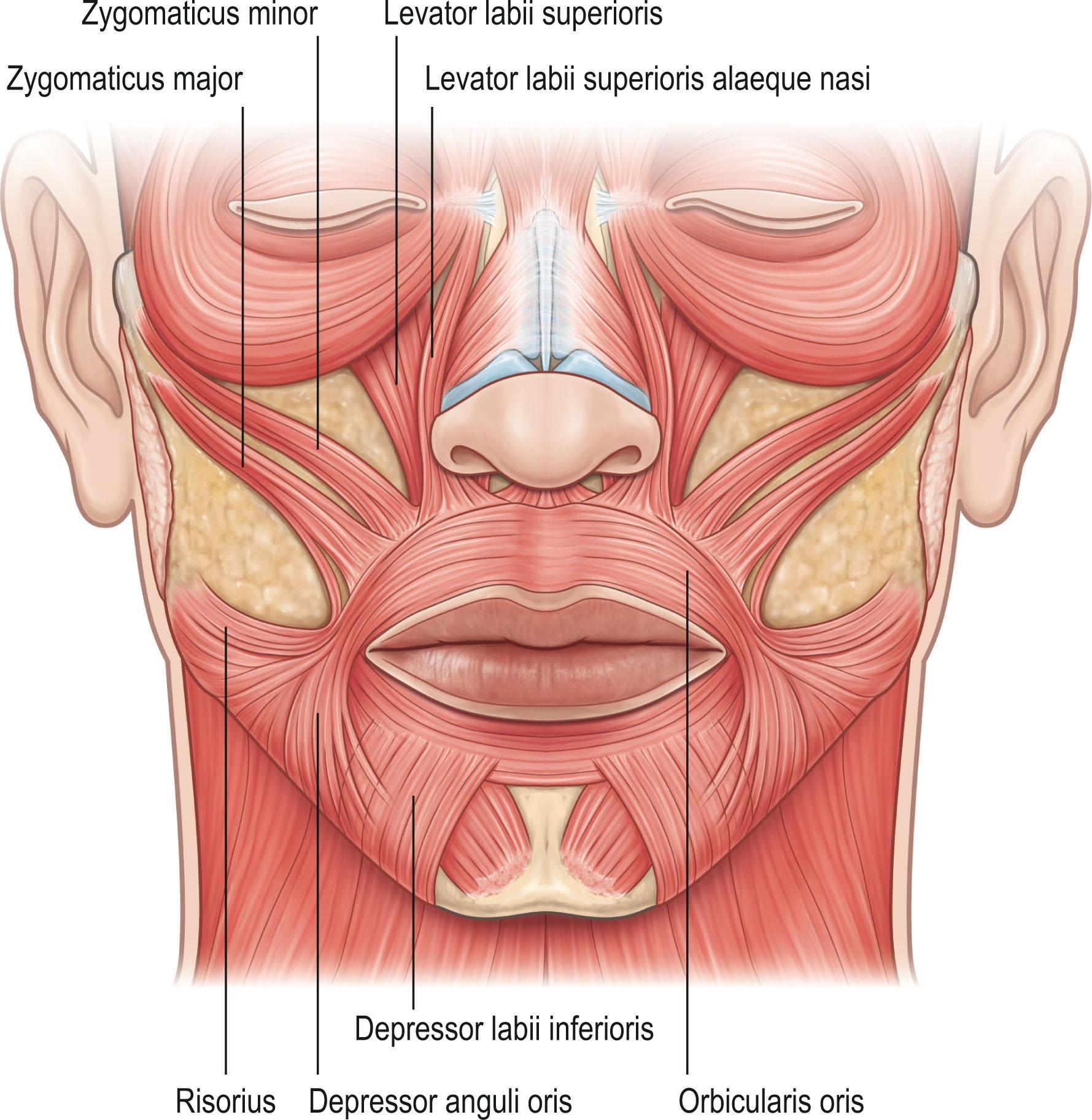Physical Address
304 North Cardinal St.
Dorchester Center, MA 02124
While normal appearance of the lip is ideal, the primary objective of lip reconstruction is the restoration of a functional oral sphincter with adequate aperture for proper feeding and speech.
Etiology, size, and missing components of the lip defect must be assessed.
Vermilion defects should preserve the vermilion border whenever possible.
Partial-thickness defects involving less than a quarter of the upper lip may benefit from a simple wedge excision for three-layer anatomic reconstruction.
Defects involving up to 10–25% of the upper lip may be closed primarily; if a larger defect is to be created, incisions should be placed at anatomic boundaries to allow for the best cosmetic outcome.
Defects up to 50% of the upper lip require reconstruction with local flaps, typically based on the opposite lip or surrounding cheek tissue.
Defects involving up to one-third of the lower lip can tolerate primary closure due to the lack of a third subunit compared with the upper lip.
Larger defects of the lower lip are amenable to similar reconstructive techniques as the upper lip, with a few notable exceptions such as the Abbe flap, which is rarely used.
Total lip defects require multiple operations over a prolonged period, including regional or free-flap transfers, to end up with what is often a suboptimal result.
Postoperative considerations for all lip repairs include nutrition, hygiene, and splinting to minimize complications.
![]() Access video lecture content for this chapter online at Elsevier eBooks+
Access video lecture content for this chapter online at Elsevier eBooks+
As with any plastic surgical procedure, one must consider the goals that are to be accomplished once the reconstruction is complete. When undertaking a reconstruction of the lips, these goals are both cosmetic and functional. Complicating both of these goals is the inherent mobility of the lips, which can be compromised by scarring, radiation, and denervation.
Cosmetic goals of lip reconstruction involve restoration of the natural anatomy, of which there are several subunits ( Fig. 11.1 ). The primary difference between the anatomy of the upper and lower lips is the presence of the philtrum and associated Cupid’s bow of the upper lip, which divide the upper lip into its subunits. The philtral columns, created by contralateral orbicularis oris fibers that attach to the underlying dermis, extend from the vermilion to the nasal base. At the inferior extent of these columns lies Cupid’s bow, so named because of its resemblance to the god of love’s weapon. Inferior to that structure are the three tubercles of the upper lip, one centrally and two laterally. This differs from the lower lip, which only contains two symmetric tubercles and lacks any significant defining features on its cutaneous portion. Laterally, the oral commissure is the junction between the upper and lower lips and presents a difficult reconstructive challenge when violated. Not only is the commissure and its underlying fibrous modiolus, which serves as a site for intersecting muscle attachment, a distinct anatomic feature of the lip, it also plays a key role by preventing the spillage of oral contents out of the corner of the mouth.

A crucial component of lip reconstruction is the precise alignment of the vermilion border, or mucocutaneous ridge. This well-vascularized structure lacks minor salivary glands and has a thin overlying epithelial layer. The red vermilion represents the transition from its external keratinized squamous epithelium to the non-keratinized squamous epithelium of the oral mucosa. Regarding the white roll surrounding the vermilion, its contour and color is created by the pars marginalis fibers of the orbicularis oris. As little as a 1 mm misalignment of this junction between the cutaneous and vermilion red lip can be noticeable at conversation distance. Both the vermilion and the white roll are widest at the central lip, gradually tapering laterally. In order to reapproximate the white roll, techniques such as intraoperative methylene blue tattooing of the respective edge may be employed to ensure those points are precisely aligned.
The restoration of the normal harmonious contour of the lips is also an important cosmetic consideration. On profile, the upper lip protrudes anteriorly relative to the lower lip, and in both lips there is a slight Indentation beyond the vermilion borders. When this harmony is lost, particularly in patients with cleft lip deformity and in some burn patients with severe contractures and lip ectropion, obvious and marked deformity results. Finally, in the male, the restoration of hair-bearing skin components of the lip is also an important cosmetic consideration when planning reconstruction.
The origins of lip reconstruction began thousands of years ago. One of the earliest examples came from Celsus, who described cheek-releasing incisions to allow for closure of lower lip defects in the first century CE. The pace of advancement in surgical technique accelerated in the nineteenth and twentieth centuries, beginning with Dieffenbach’s description of bilateral cheek advancement flaps for one lip reconstruction in 1834. In 1838, Sabattini was the first to describe the transfer of a flap from the lower to the upper lip, popularized by Abbe some 60 years later. Conversely, Stein reconstructed the lower lip with two flaps from the upper lip in 1848. This was later modified by Kazanjian and Roopenian in 1954 to leave the philtrum intact. Bernard’s procedure in 1853 and Webster’s subsequent modification in 1960 describe full-thickness triangular excisions in the nasolabial sulcus, allowing for medial advancement of malar flaps for upper lip reconstruction. For lower lip reconstruction, Bruns utilized bilateral nasolabial flaps in 1857.
Wartime often brings about surgical advances, as evidenced by Buck’s lip-switch flap from the lower to the upper lip during the American Civil War in 1864. Estlander made a significant contribution to the reconstruction of the commissure with his technique published in 1872. For vermilion reconstruction, Von Esmarch utilized a lip shave procedure and mucosal advancement in 1892. Sir Harold Gillies provided numerous examples of reconstructive methods developed during wartime, including his rhomboid-like fan flap to rotate cheek and upper lip tissue for reconstruction of lower lip defects in 1957. This was later modified by Karapandzic in 1974 and McGregor in 1983 for reconstruction of large defects. Nakajima described a variation of the McGregor technique where he preserved the nerve supply. Finally, in 1987 Rayner and Arscott described the resurfacing of large lip defects with sensate musculo-mucosal flaps from the cheeks. In 1992 Pribaz et al . refined this when they described a versatile axial intraoral flap, the facial artery musculomucosal (FAMM) flap, which can be used to repair multiple intraoral, tongue, palatal as well as lip defects, especially for full-thickness vermilion loss.
While normal appearance of the lip is ideal, the primary objective of lip reconstruction is the restoration of a functional oral sphincter with adequate oral aperture to enable proper feeding and speech. Appropriate oral aperture and adequate depth of the lip sulci are important, particularly in the lower lip, in maintaining proper oral and dental hygiene, preventing drooling, and allowing patients to wear dentures or other removable prostheses. A secondary goal accomplished in the restoration of this sphincter and the surrounding musculature is the ability to animate the lips for the expression of emotion.
These goals are satisfied by careful reapproximation of the orbicularis oris, which is composed of two layers. The pars marginalis lies anterior beneath the vermilion and functions to protrude the lips outward. The deeper pars peripheralis extends to the cutaneous lip from an area deep to the pars marginalis and brings the lips in toward the maxillary and mandibular arches. When combined, this creates the “pucker” motion.
The remainder of the musculature in this region primarily serves the purpose of facial expression ( Fig. 11.2 ). Upper lip elevators are innervated by buccal branches of the facial nerve and include, from medial to lateral, the levator labii superioris alaeque nasi, levator labii superioris, zygomaticus minor, zygomaticus major, and risorius. Depressors of the inferior lip include the depressor labii medially and the depressor anguli oris laterally, which are innervated by mandibular branches of the facial nerves. The depressors and levators intersect just lateral to the commissures at the fibrous modiolus. This structure can often be marked by a dimple, which represents the center of the dermal insertion of the two heads of the zygomaticus major. The platysma extends superiorly from the neck and may also play a role in lower lip depression. Conversely, the mentalis muscle contracts against the mandible, raising the lower lip to create a “pout”. Posteriorly, the buccinator and pharyngeal constrictors insert on the lip to force it posteriorly against the intraoral sulci.

Blood supply to the upper and lower lip is provided by the superior and inferior labial arteries, respectively, which originate from the external carotid artery via the facial artery, which branches approximately 1.5 cm lateral to the oral commissure. While the anatomy is variable, these typically course between the lip mucosa and orbicularis oris and anastomose at the midline, although the inferior labial artery has been shown to have various branching patterns. Venous drainage does not follow the arterial pattern, but a dense venous syncytial plexus exists in the lips, which eventually empties into the facial vein located more laterally in the cheek and lateral to the facial artery.
Sensory innervation to the upper and lower lip is provided via the maxillary and mandibular divisions of the trigeminal nerve, respectively. Loss of sensory innervation can eliminate the ability to distinguish hot versus cold during oral intake, or the ability to sense inadvertent trauma to the lip during mastication. Motor innervation to the orbicularis oris and all surrounding muscles of facial expression is controlled by the buccal and marginal mandibular branches of the facial nerve, with potential contributions from the cervical branch to the lip depressors. All of these muscles are innervated on their deep surface, with the exception of the mentalis, levator anguli oris, and buccinator. Disruption of motor innervation can be a particularly devastating consequence, as this compromises the functional oral sphincter, diminishing or potentially eliminating the ability to perform actions such as speaking, eating, drinking, and sucking.
Lip defects fall into three major etiologic classes: traumatic, malignant, and congenital. Traumatic defects can present secondary to any of a variety of mechanisms, from motor vehicle collisions to animal bites. As with all lip defects, they should be assessed to determine the structures involved that require reconstruction. While these injuries often appear large on initial assessment, the tissue edges tend to gape due to the sphincteric forces of the orbicularis oris and typically do not have loss of tissue once the wound is cleaned and thoroughly examined.
In terms of malignant lesions, the vast majority of cancers of the lip occur on the lower lip, likely due to its increased sun exposure. Squamous cell carcinoma is the most common overall, while basal cell carcinoma is the most common on the upper lip. Defects may also be congenital in nature, such as in patients with cleft lip and palate, although the unique reconstructive methods utilized in their repair is beyond the scope of this topic.
Defect size dictates the amount of tissue required for appropriate reconstruction. Classically, the size of the defect and the subsequent reconstructive methods are classified according to thirds in the lower lip and quarters in the upper lip. This is due to the unique anatomic structures of the upper lip that are more easily distorted.
Become a Clinical Tree membership for Full access and enjoy Unlimited articles
If you are a member. Log in here